Navigating Enterprise Excellence: A Practical Guide to TOGAF Implementation
Introduction
In the dynamic realm of enterprise architecture, where complexities abound, having a reliable guide becomes imperative. Enter TOGAF, The Open Group Architecture Framework, a beacon illuminating the path to efficient and strategic architectural practices. This practical tutorial aims to demystify TOGAF, unraveling its core components and methodologies. From the iterative dance of the Architecture Development Method (ADM) to the structured frameworks of Reference Models and the human touch in the Architecture Capability Framework, this guide is your compass in the intricate landscape of enterprise architecture.
A Journey through TOGAF’s History
The history of The Open Group Architecture Framework (TOGAF) is a tale of evolution and collaboration, reflecting the dynamic landscape of enterprise architecture. TOGAF’s journey can be traced back to the mid-1990s, and its development has been shaped by the collective efforts of industry experts and organizations striving to standardize and improve enterprise architecture practices.
1995: The Birth of TOGAF The origins of TOGAF can be attributed to The Open Group, an international consortium of technology and IT standards organizations. In 1995, the first version of TOGAF was introduced, aiming to provide a methodological framework for enterprise architecture. This initial version laid the groundwork for subsequent editions, establishing a structured approach to architectural development.
2001: TOGAF 7 In 2001, TOGAF 7 was released, marking a significant step forward. This version incorporated practical experiences and feedback from organizations that had implemented earlier versions. TOGAF 7 focused on refining the Architecture Development Method (ADM) and introduced a more comprehensive set of guidelines and best practices.
2005: TOGAF 8 – An Expanded Framework TOGAF 8, released in 2005, brought about a notable expansion of the framework. This version introduced a more modular structure, making it easier for organizations to adopt specific components based on their needs. TOGAF 8 also emphasized the importance of aligning enterprise architecture with business goals and strategies.
2009: TOGAF 9 – A Major Milestone TOGAF 9, released in 2009, represented a major milestone in the framework’s evolution. This version integrated valuable lessons from previous editions and introduced a renewed focus on adaptability and flexibility. TOGAF 9 emphasized the iterative nature of the ADM, accommodating the dynamic nature of business and technology landscapes.
2011: The Open Group’s TOGAF Certification Program Recognizing the growing importance of TOGAF in the professional landscape, The Open Group introduced the TOGAF Certification Program in 2011. This program allows individuals to demonstrate their proficiency in TOGAF, contributing to the widespread adoption and recognition of the framework.
2018: TOGAF 9.2 – Continuous Improvement TOGAF 9.2, released in 2018, continued the tradition of continuous improvement. This version refined and clarified various aspects of the framework, enhancing its usability and relevance. TOGAF 9.2 aimed to provide practitioners with a more streamlined and user-friendly experience.
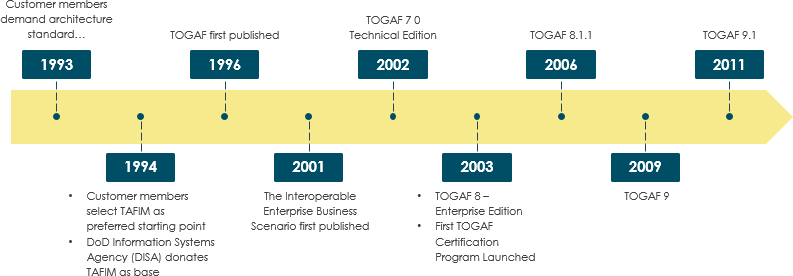
Throughout its history, TOGAF has evolved in response to the ever-changing demands of the business and technology landscape. Its success is attributed to the collaborative efforts of The Open Group, industry experts, and the global community of practitioners committed to advancing the field of enterprise architecture. TOGAF’s history reflects a commitment to excellence, adaptability, and the ongoing pursuit of best practices in enterprise architecture.
1. Why TOGAF?
In the ever-evolving landscape of enterprise architecture, the need for a standardized approach to design and planning has become increasingly apparent. TOGAF, or The Open Group Architecture Framework, emerges as a stalwart in this domain. But why TOGAF? It’s not just an acronym; it’s a comprehensive methodology that equips organizations with the tools and guidelines to develop and manage their enterprise architecture. This section explores the fundamental reasons behind the adoption of TOGAF, shedding light on its pivotal role in steering enterprises toward efficient and strategic architectural practices.
Enterprise architecture serves as the blueprint for an organization’s structure and operations. As businesses grapple with complex challenges and dynamic environments, having a standardized framework becomes imperative. TOGAF stands out for its ability to provide a systematic and holistic approach to enterprise architecture, facilitating seamless communication, efficient decision-making, and adaptive strategies.
2. TOGAF 9 – Six Components
TOGAF 9, the latest iteration of the framework, is organized into six essential components. This section offers an overview of TOGAF 9, outlining its key features and setting the stage for a more in-depth exploration of each component. The six components act as pillars that collectively support the development and maintenance of robust enterprise architectures.
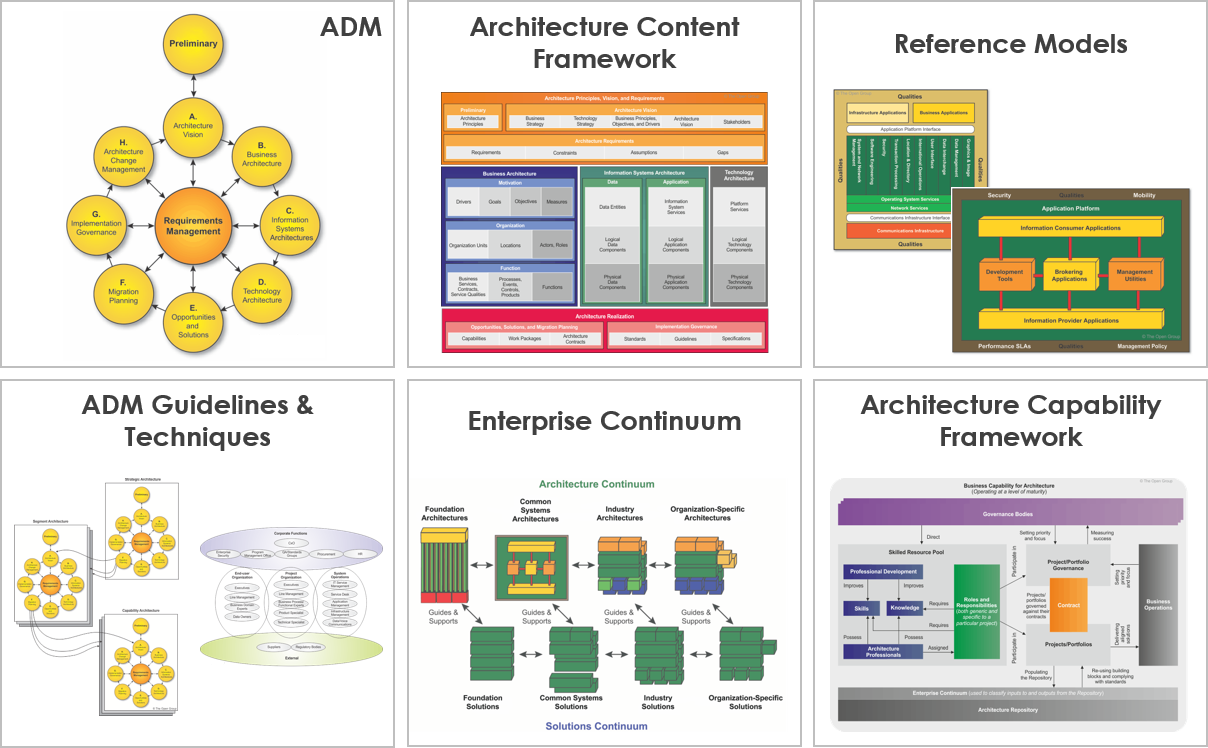
These components are not isolated entities; rather, they form an interconnected system that guides organizations through every phase of the architecture development process. From defining the problem at hand to implementing and governing solutions, TOGAF 9’s components provide a comprehensive roadmap for architects and decision-makers alike.
3. ADM: The Central Part of TOGAF
At the heart of TOGAF lies the Architecture Development Method (ADM), a central and indispensable component. This section delves into the essence of ADM, explaining its role as the primary methodology for developing enterprise architectures. ADM is not a rigid, one-size-fits-all approach; rather, it embraces an iterative and cyclical process that accommodates the dynamic nature of business and technology.
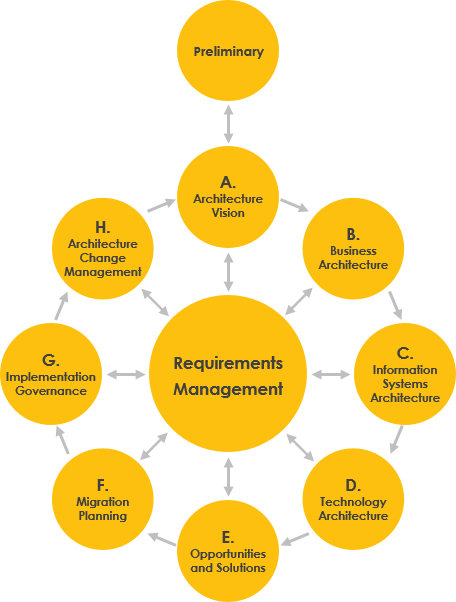
Understanding ADM is paramount for those aiming to leverage TOGAF effectively. As we unpack the iterative approach embedded in ADM, its significance in shaping the overall TOGAF framework becomes apparent. With ADM as the linchpin, organizations can navigate the complexities of architectural development with agility and precision, ensuring that their enterprise architectures align with business objectives and industry best practices.
4. ADM – Iterative Approach to the TOGAF ADM
Within TOGAF’s Architecture Development Method (ADM), the iterative approach emerges as a guiding principle, enabling organizations to adapt and refine their architectural endeavors. This section breaks down the iterative process within ADM, elucidating how it fosters flexibility and responsiveness. By embracing iteration, organizations can cyclically revisit and enhance their architectural strategies, ensuring alignment with evolving business needs.
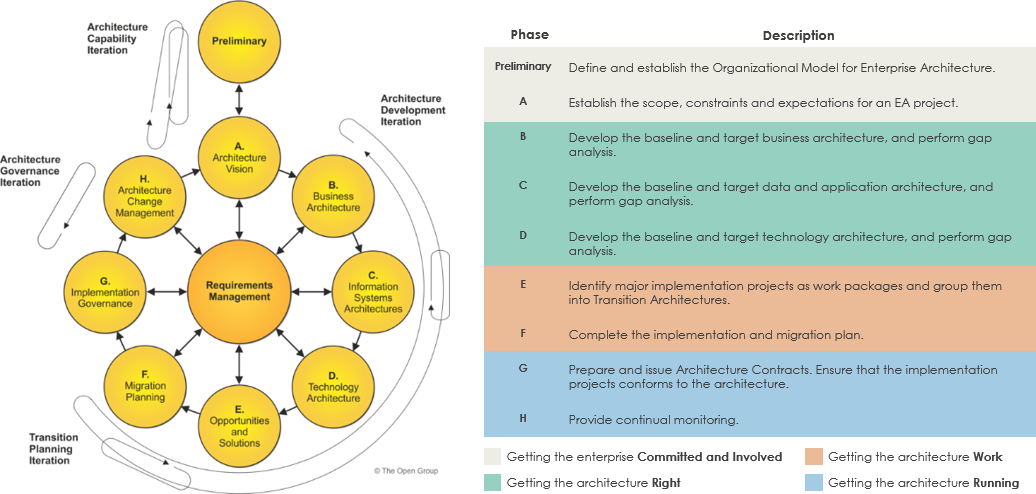
The iterative nature of ADM accommodates the dynamic nature of enterprise environments. It allows architects to revisit and refine architectural phases, incorporating feedback and insights gained during previous iterations. This cyclical process not only enhances the adaptability of the architecture but also facilitates continuous improvement, making it a vital aspect of TOGAF’s effectiveness.
5. ADM Input and Output
Effective architecture development relies on a structured flow of information. This section dissects the input and output mechanisms within ADM, elucidating the key data points that shape the architectural process. Understanding the inputs required and the outputs generated at each phase is crucial for architects aiming to create coherent and well-informed enterprise architectures.
Inputs in ADM encompass a variety of data, including business goals, stakeholder concerns, and existing architectural artifacts. As architects traverse through the ADM phases, these inputs undergo transformation, ultimately culminating in valuable outputs such as architecture models, specifications, and plans. By comprehending this flow of information, architects can ensure that their decision-making is informed by a rich tapestry of relevant data.
6. Deliverables
In the realm of TOGAF’s ADM, deliverables serve as tangible artifacts that encapsulate the outcomes of architectural efforts. This section navigates through the key deliverables in TOGAF’s architecture development process, shedding light on their significance and role in ensuring the quality and coherence of the final architecture.
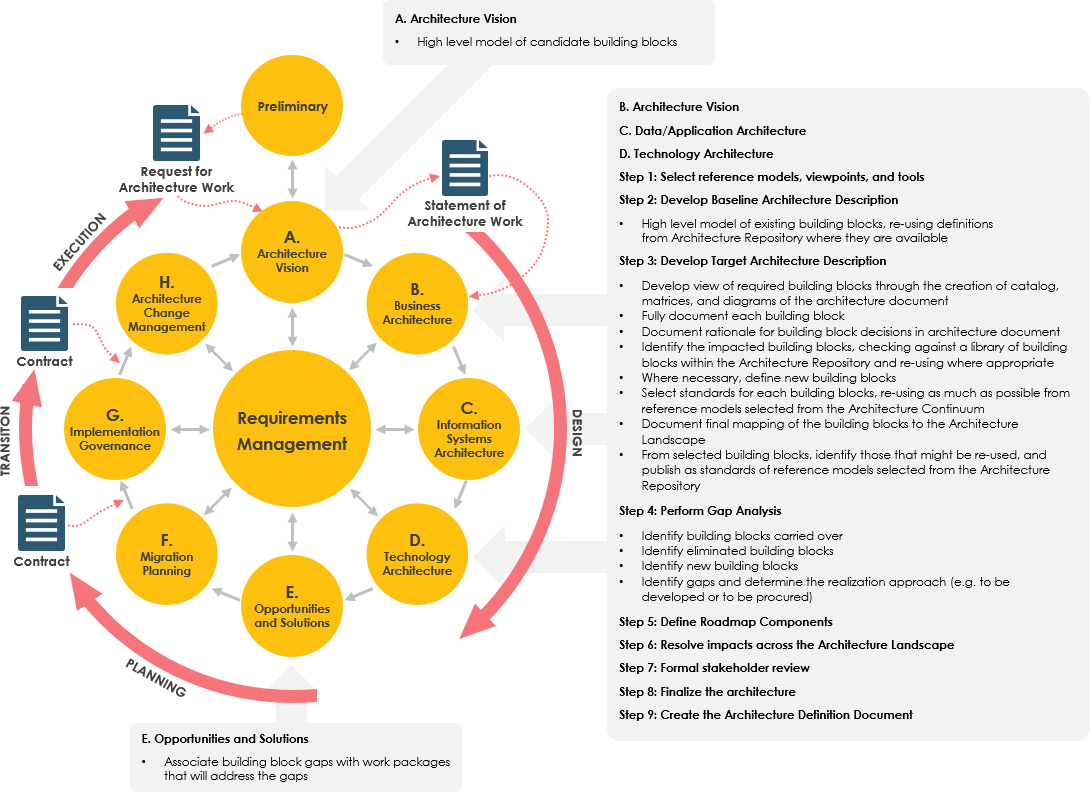
Deliverables are not mere documentation; they are tools for communication and decision support. Whether it’s an architecture vision document or a detailed implementation and migration plan, each deliverable serves a specific purpose in guiding the organization towards its architectural objectives. By emphasizing the creation and utilization of these deliverables, TOGAF empowers architects to articulate, validate, and implement architectures that align with business goals and industry standards.
7. ADM Guidelines and Techniques Component
Navigating the intricacies of TOGAF’s Architecture Development Method (ADM) requires a nuanced understanding of guidelines and techniques. In this section, we explore the significance of guidelines for effective implementation and the diverse set of techniques available to enhance the ADM process.
Guidelines provide a structured approach for architects to follow during the development of enterprise architectures. These guidelines serve as guardrails, ensuring consistency and best practices throughout the process. On the other hand, techniques are the tools that architects wield to analyze, design, and implement architectural solutions. From SWOT analysis to scenario planning, the arsenal of techniques within TOGAF empowers architects to tackle complex challenges and make informed decisions.
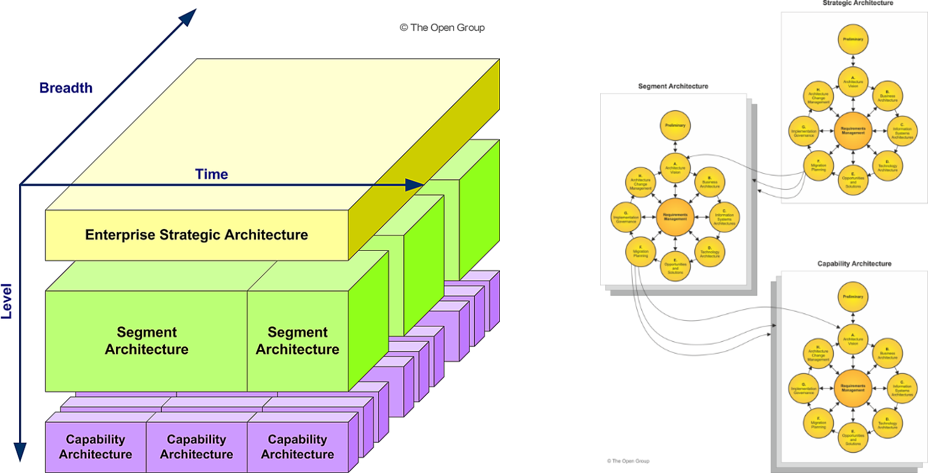
8. Architecture Content Framework Component
Central to TOGAF is the Architecture Content Framework, a component that deals with the building blocks of architectural content. This section delves into the intricacies of this framework, outlining how it structures and organizes the essential elements of enterprise architectures.

The Architecture Content Framework provides a systematic way to capture, organize, and present architectural information. It comprises artifacts, building blocks, catalogs, matrices, and diagrams, forming a comprehensive structure for architects to work within. Understanding and effectively utilizing this framework enhances the clarity and coherence of the architectural content, ensuring that it aligns with organizational goals and stakeholder needs.
9. Enterprise Continuum
Enterprise architecture is a journey, not a destination. The Enterprise Continuum, as explored in this section, is a critical component of TOGAF that reflects this dynamic nature. It provides a systematic way to categorize and manage architectural assets over time.
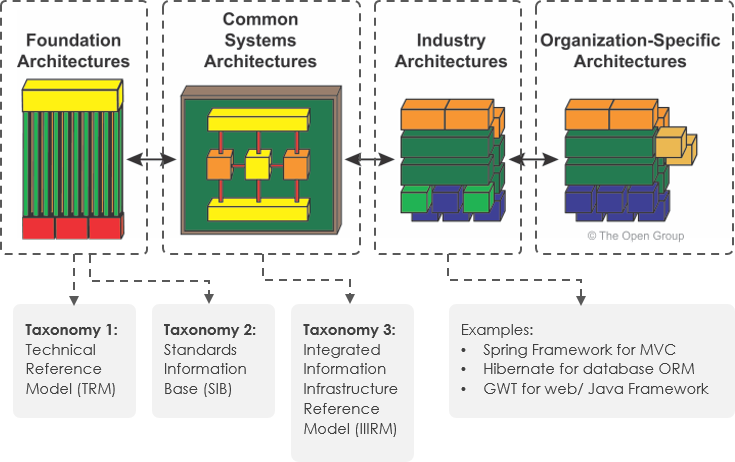
In essence, the Enterprise Continuum is a repository of architectural assets that span from generic solutions to tailored implementations. Understanding the Continuum allows architects to leverage existing assets, avoid duplication of efforts, and maintain consistency across the enterprise. By organizing architectural artifacts into an evolving Continuum, TOGAF equips organizations to navigate the complexities of architectural evolution with strategic foresight.
10. Reference Models
Reference Models play a pivotal role in TOGAF, providing standardized frameworks that guide architectural development. This section offers an overview of Reference Models, outlining their importance in the TOGAF framework and their role in ensuring consistency and alignment with industry best practices.
Reference Models serve as benchmarks for architects, offering predefined structures and methodologies. From information architectures to technical architectures, these models provide a common language and set of principles that facilitate effective communication and decision-making. Understanding and leveraging Reference Models within TOGAF enhances the robustness and reliability of architectural solutions.
11. Relating Reference Models to Architecture Continuum
Building on the concept of the Architecture Continuum, this section explores the interplay between Reference Models and the Continuum. It illustrates how architects can establish connections between models and Continuum, fostering a holistic approach to architectural development.
Relating Reference Models to the Architecture Continuum ensures that architectural decisions align with the broader context of the enterprise’s goals and strategies. This integration enhances the coherence of the architectural landscape, promoting interoperability and adaptability. By understanding the relationship between Reference Models and the Continuum, architects can craft architectures that are not only sound in isolation but also seamlessly integrated into the enterprise ecosystem.
12. Architecture Capability Framework Component
In the final section of our practical tutorial, we delve into the Architecture Capability Framework Component. This component addresses the human and organizational aspects of enterprise architecture within TOGAF, emphasizing the importance of building and enhancing architecture capabilities.
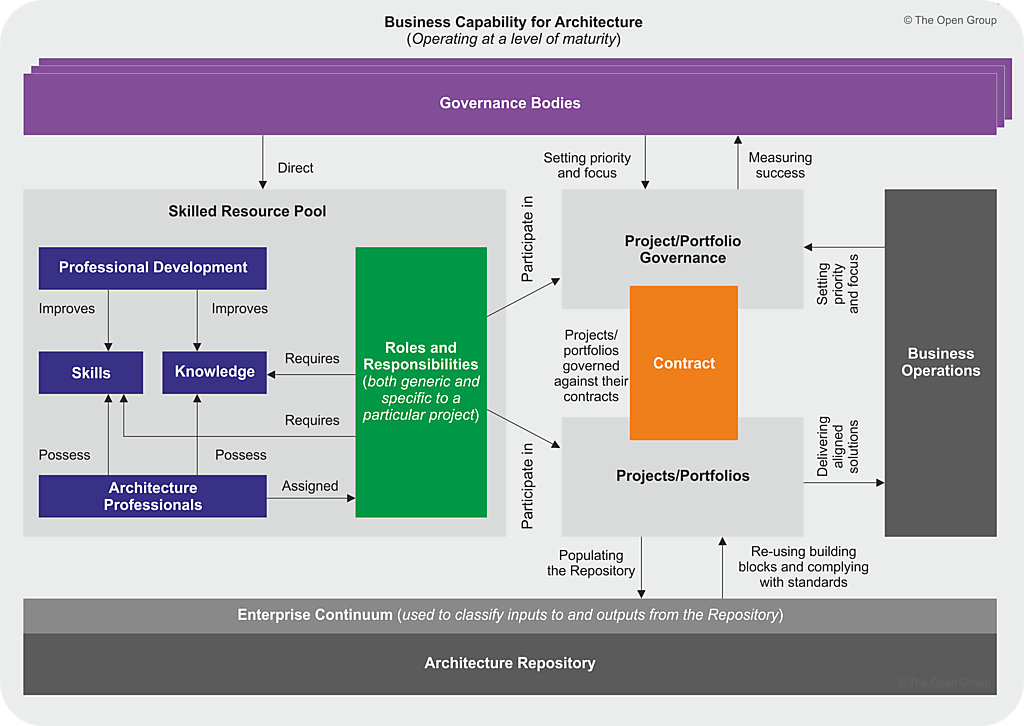
The Architecture Capability Framework Component recognizes that successful architecture development is not solely dependent on methodologies and tools but also on the skills, roles, and processes of the people involved. It provides a structured approach to developing and managing these capabilities, ensuring that organizations have the talent and processes in place to effectively leverage TOGAF. By focusing on the human element, TOGAF’s Architecture Capability Framework empowers organizations to build a sustainable and adaptive architecture practice.
Summary
As we traverse the chapters of this tutorial, we uncover the “why” behind TOGAF, exploring its pivotal role in effective enterprise architecture. We dissect TOGAF 9’s six components, laying the foundation for a comprehensive understanding. The heart of TOGAF, the ADM, unfolds with its iterative approach, guiding architects through the cyclical journey of architectural development. From input and output mechanisms to tangible deliverables, we unravel the intricacies of the ADM process.
Guidelines and techniques become our tools in the next phase, followed by a deep dive into the Architecture Content Framework, providing a structured approach to architectural elements. The journey continues with the dynamic nature of the Enterprise Continuum and the standardized frameworks of Reference Models. Finally, we explore the human element in architecture, understanding the Architecture Capability Framework.
This guide is your companion, equipping you with the knowledge to harness TOGAF’s potential. Whether you’re a seasoned architect or a newcomer, let’s embark on this journey to navigate the seas of enterprise excellence together.

